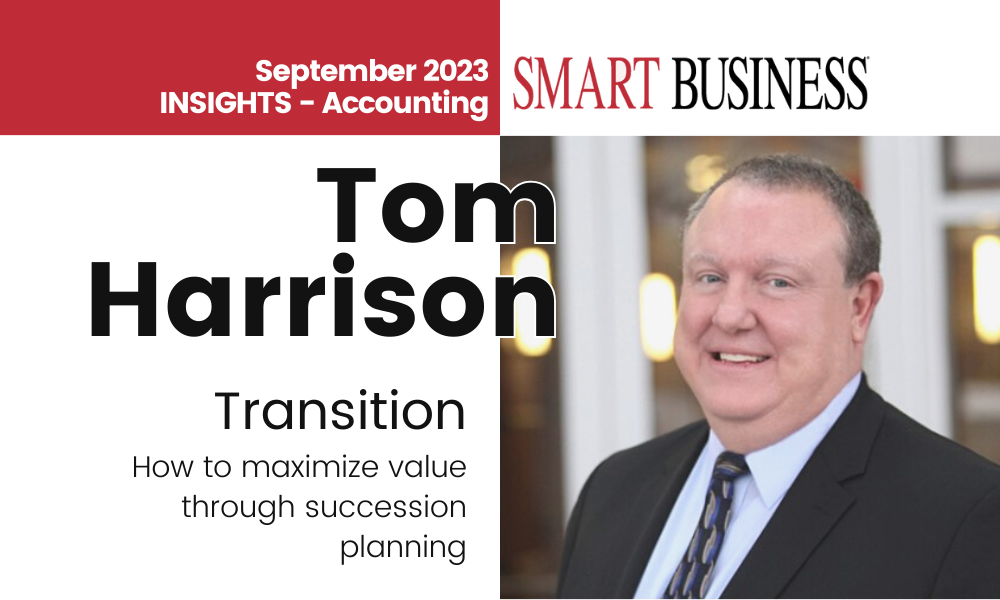
Corrigan Krause President & CEO Tom Harrison recently talked with Smart Business about how business owners can better manage their cash flow during uncertain times. Below is the full interview, which appeared in the September 2023 issue of Smart Business.
Transitioning a closely held business through a succession plan is often a once-in-a-lifetime event for business owners. They’re passing along what is typically their largest asset to a family member, an outside party or key employees, so there’s a lot to consider.
“It’s not just a financial transition,” says Tom Harrison, President and CEO of Corrigan Krause. “It’s the transition of the whole venture — leadership, talent, technology, culture, vendors and customers.”
While it’s a process that, ideally, should start when the business launches, there are strategies to maximize value that can be implemented much later in the company’s lifecycle.
Smart Business spoke with Harrison about succession planning for business owners.
What are some of the options when it comes to transitioning?
An owner can transition their business to a family member or an outside party, such as a strategic or financial buyer. Another transitional possibility is utilizing the Employee Stock Ownership Plan (ESOP).
The best transition option isn’t necessarily the one that returns the highest dollar amount to the owner. Owners need to determine for themselves what success is. That could mean finding a deal that takes care of their employees rather than maximizes the financial return to the owner.
How can owners maximize value?
The value of a business has a lot to do with what produces the most revenue for it, but there are other intangible characteristics that can significantly factor in the overall value of a business. The first step for an owner is to identify and quantify that value. Once identified, an owner should protect, build and then harvest that value. While this is a process that’s undertaken throughout a company’s lifecycle, it’s particularly important that these value-adding characteristics are clearly defined and maximized ahead of a transition.
Another important consideration is organizational development. There are essentially four key components of this: human capital, customers, entity structure and culture.
Human capital is the talent a company has on staff. It’s important for an owner to be sure they have the right team in place.
Customers are an important component. A business should align with clients and customers that value its services or products.
The company’s entity structure should align with its hierarchy of people, and its legal structure should be set up properly.
Lastly, a company should have a high-quality, high-performing culture that understands and works toward achieving the company’s mission.
Business owners should also make sure all their contracts and agreements are in order. The typical agreements needed for a business succession plan are: operating agreements, buy-sell agreements, employment agreements, non-compete agreements, lease agreements, loan documents and vendor agreements. Together, these documents comprise a company’s backroom. Outside potential buyers will want to see that all of these internal documents are in order. If they are, it adds additional credibility to the seller.
Owners should confirm there are no issues within their legal documents that could cause problems in a transition. For example, a poorly written outside vendor contract could put a kink in a deal, cause delays or, in extreme cases, make the potential sale of the company invalid.
Still, despite thorough planning, there are events outside an owner’s control that can derail a succession plan, such as the decline in the health of the stakeholders or an economic downturn. Having alternative plans can mitigate the risks that stem from such events.
Who can help owners with a transition?
Business owners should work with an advisory team when putting together a succession plan. That could include accountants, attorneys, wealth managers, bankers and insurance professionals, among others. Having multiple ideas from professionals who have been through many succession plans can form a better overall strategy for the owner. Going through the transition of the owner’s largest asset deserves the investment to assure that the owner hits their maximum value.
Corrigan Krause is a Business Owner’s Partner
Our proactive and comprehensive approach to servicing and managing our clients’ business needs allows us to stay ahead of changing regulations and fluctuating cycles you may experience. By building a strong relationship with our clients, holding quarterly planning meetings and immersing ourselves in your operations and goals, Corrigan Krause is in the unique position to uncover opportunities for you and to recommend a comprehensive package of services that benefit you in the long run. For information on becoming a Corrigan Krause client, email info@corrigankrause.com.

